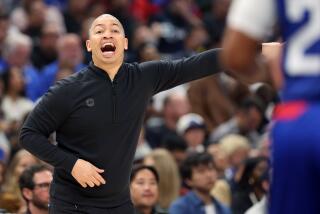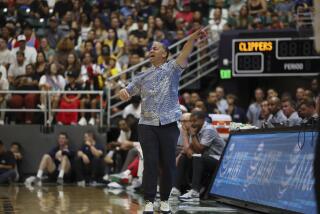CLIPPERS
- Share via
Midway through the second exhibition game between the Lakers and Clippers last weekend, Kobe Bryant drove the lane and was met hard by Rodney Rogers’ forearm. It was a subtle hit, but it spoke volumes about this season’s Clipper team.
A night earlier, Rogers had taken a hard foul from the Lakers’ Shaquille O’Neal, and not one Clipper had responded with a similar blow as the Lakers laughed their way to a 31-point victory.
The next game, the Clippers were still overmatched, but they at least showed the type of fight they will need if they are going to turn things around under first-year Coach Chris Ford.
“There’s a difference between [playing with] energy and playing soft . . . you have to play tough,” said Ford, who became coach just before training camp. “We have some great big bodies. Guys who can do a lot of damage [inside].”
When the Clippers fired Bill Fitch after the team finished 17-65 last season, it was unclear what direction the franchise wanted to go.
Gone from last year are forward Loy Vaught, not re-signed after missing most of last season because of back surgery; center Ike Austin, not re-signed after being acquired in a trade from Miami late last season; and Fitch, let go after compiling a 99-209 record with the Clippers over four seasons.
New to the mix are center Michael Olowokandi, the No. 1 draft choice from Pacific; forward Brian Skinner, drafted 22nd overall from Baylor; and Ford, who was fired by Milwaukee after last season and has a 291-283 coaching record.
“We’re going to be OK. . . . We’re going to have to go out there every night and try to win more ballgames than we did last season,” said Rogers, beginning his fourth season with the Clippers. “It’s a short season, but we can’t hold anything back. . . . We want to change everything here into a positive and not be negative. That’s something Coach Ford is striving for.”
Changing the team’s losing image became more important when owner Donald Sterling decided to move the Clippers from the aging Sports Arena to the Staples Center, when the downtown arena opens in the fall.
With the move, however, the Clippers took on a new problem. For the team not be treated like a third tenant behind the Lakers and Kings at the Staples Center, it has to start winning.
Ford’s goal this season is to build a foundation for the future. In recent years, the Clippers’ biggest problem has been a lack of stability. Good players keep coming and going, while mediocre players have remained. One reason Ford was chosen is that Elgin Baylor, vice president of basketball operations, believes he’s the right man to lead the rebuilding process.
His strategy for success is simple: Pass the ball to the open man, take the shot when it’s there and always help out on defense. For this to work, the Clippers, who lack players who can create their own shots, will have to have great team chemistry.
Ford wants his players communicating and trapping on defense to take advantage of their versatility.
“The guys are picking it up well, and I know I like it a lot because it keeps everyone moving,” Rogers said. “No one is just standing still. That’s something that we needed. Sometimes, we’ve given teams too many wide-open shots. Coach Ford’s defensive strategy requires everybody rotating. Now, you’re really going to have to be out of place to give anyone an open shot.”
With Olowokandi joining Maurice Taylor, Lorenzen Wright and Rogers in the frontcourt, the Clippers will have an inside presence to help make Ford’s defense work.
Olowokandi wasn’t expected to join the team until Feb. 15 because of a contract he signed to play in Italy two days before the NBA labor agreement was reached. But Olowokandi got an early release from Kinder Bologna and began practicing with the team last Sunday. In the few workouts he has had this week, Olowokandi has been impressive.
He has the type of toughness Ford talks about. His overall game lacks polish (he played only 77 games of organized basketball at Pacific before being drafted), but his confidence and determination are leadership qualities.
Taylor spent most of training camp nursing a thigh injury but has practiced this week and will be ready to start the season Friday against the Phoenix Suns. The need to get him more playing time is one reason the Clippers didn’t bring back Vaught. Taylor averaged 11.5 points and 4.2 rebounds as a rookie.
Wright spent most of training camp playing center in Olowokandi’s absence, but power forward is his natural position. Wright is capable of grabbing 10 rebounds a game and is in the final year of his contract.
If Ford gives quality minutes to Taylor and Wright, Rogers will get plenty of action at small forward. He slowly is working his way into shape and remains one of the best three-point shooters on the team.
Skinner will not be available for at least the first two weeks because of a knee injury but will add even more physical play inside. Don’t expect many minutes from backup centers Stojko Vrankovic or Keith Closs, unless the Clippers are at a size disadvantage or Olowokandi and Wright get into foul trouble.
On offense, the Clippers will count on Lamond Murray to be their main scoring threat. He’ll play small forward and shooting guard in an offense that includes some of the same triangle principles used by Chicago last season.
Opponents will probably key on Murray and try to force him into poor shots. If this happens, it will be up to the rest of the team to score, which could be a problem.
Olowokandi’s shooting still needs work. Rogers can produce points but he may lose minutes as Taylor’s game continues to improve. Wright and Skinner are better rebounders than scorers.
If the Clippers have to rely on their backcourt for points, guards Eric Piatkowski and James Robinson will have to shoot better than they did in the two exhibition games, when they combined for five-for-24 shooting from the field against the Lakers.
Piatkowski has worked hard throughout training camp, and Ford says that Robinson has been one of the team’s best defenders, but unless they are producing points, Murray may be the shooting guard to help give more minutes to the forwards.
Free agent Tyrone Nesby, a rookie small forward from Nevada Las Vegas, might also have a role because of his scoring mentality. Nesby has impressed Ford with his willingness to attack the basket.
“Our strength is still inside with Michael, Lorenzen, Mo and Rodney,” Ford said.
“It should free up our perimeter game if our post players do what we hope they can do. What I really like is that we’re moving the ball to the open guys.”
Darrick Martin will start at point guard after re-signing the first day of training camp. Martin, who will be backed up by Pooh Richardson, wasn’t the Clippers’ first choice among free-agent point guards, but he has been steady.
Martin and Richardson have yet to show the consistent outside shooting touch Ford wants from the position, but they both have pleased their coach.
“They’ve tried to give what their coach wants and that’s distribute the ball, try to get us into our offense and try to get us into a push-up game,” said Ford, who will also use Charles Smith in the backcourt. “They both have done that. I think they’ll continue to grow and get better in the system as we progress.”
If the Clippers can buy into Ford’s system, they should improve on last season. But only time will tell.
(BEGIN TEXT OF INFOBOX / INFOGRAPHIC)
ROSTER
SCOTT BROOKS (guard)
No.: 1. Size: 5-11, 165.
Age: 33. 11th season.
Suffered knee injury in first exhibition game and is expected to be sidelined at least three weeks to begin the season.
KEITH CLOSS (center)
No.: 33. Size: 7-3, 215.
Age: 22. Second season.
A big man project who can block shots but has problems on the offensive end.
DARRICK MARTIN (guard)
No.: 15. Size: 5-11, 170.
Age: 27. Fifth season.
May finally get league-wide respect if he continues to follow Coach Chris Ford’s direction in getting everyone more involved in the offense.
LAMOND MURRAY
(forward/guard)
No.: 7. Size: 6-7, 235.
Age: 25. Fifth season.
A deadly shooter who has added penetration to his game to become the team’s top scoring threat.
TYRONE NESBY (forward)
No.: 8. Size: 6-6, 225.
Age: 23. Rookie.
A free agent who impressed the coaching staff with his scoring and ability to run the floor.
MICHAEL OLOWOKANDI
(center)
No.: 34. Size: 7-0, 265.
Age: 23. Rookie.
No. 1 draft pick has been impressive, but it is still too early to say he is the team’s savior.
ERIC PIATKOWSKI
(guard)
No.: 52. Size: 6-7, 215.
Age: 28. Fifth season.
Needs to get off to a good start to regain shooting confidence.
POOH RICHARDSON (guard)
No.: 24. Size: 6-1, 200.
Age: 32. Tenth season.
Has been solid leader from backup role and has shown some offensive spark.
JAMES ROBINSON (guard)
No.: 26. Size: 6-2, 180.
Age: 28. Sixth season.
A streaky shooter who can carry an offense at times.
RODNEY ROGERS (forward)
No.: 54. Size: 6-7, 255.
Age: 27. Sixth season.
Has worked himself into shape and will be counted on for floor leadership.
BRIAN SKINNER (forward)
No.: 32. Size: 6-9, 260.
Age: 22. Rookie.
A relentless worker whose toughness should help under the basket when he recovers from arthroscopic knee surgery.
CHARLES SMITH (guard)
No.: 5. Size: 6-4, 195.
Age: 23. Second season.
A defensive stopper who can create offensively when given the opportunity.
MAURICE TAYLOR (forward)
No.: 23. Size: 6-9, 260.
Age: 22. Second season.
A talented player who could emerge as one of the league’s top young forwards.
STOJKO VRANKOVIC (center)
No.: 11. Size: 7-2, 270.
Age: 35. Fifth season.
His size is his best attribute. Can be productive when motivated.
LORENZEN WRIGHT
(center/forward)
No.: 55. Size: 6-11, 262.
Age: 23. Third season.
May have trouble against bigger centers in the league but has a nice mid-range game that makes him a valuable forward.
More to Read
Go beyond the scoreboard
Get the latest on L.A.'s teams in the daily Sports Report newsletter.
You may occasionally receive promotional content from the Los Angeles Times.






